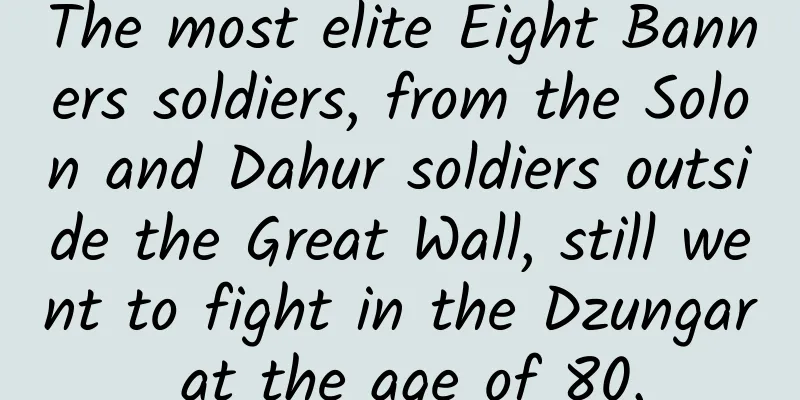The most elite Eight Banners soldiers, from the Solon and Dahur soldiers outside the Great Wall, still went to fight in the Dzungar at the age of 80.

|
Now when people mention the Eight Banners soldiers, the first thing that comes to mind is the dandy young men who "carry bird cages" in their daily lives and are "vulnerable" on the battlefield. Although, since the Qing Dynasty entered the pass, the once battle-hardened Eight Banners cavalry has rapidly declined, to the point that many people cannot draw a bow or ride a horse. However, the fighting spirit of the Eight Banners soldiers does not seem to have weakened too much. For example, during the Opium War, they captured Gulangyu, Xiamen, Dinghai, and Zhenhai along the way, and met the pure-blooded Eight Banners soldiers for the first time in Zhapu in 1841. These 300 Eight Banners soldiers, with their rear roads cut off, still fought hard until they all died, and none of them surrendered. Manchurian Zuoling Longfu died after "drawing his saber and stabbing several foreign soldiers" when he broke through the siege. When the city fell, the assistant leader Gaierhang'a led his troops to fight in the streets and died. The director Wei Fengjia and the deputy governor Changxi died one after another. However, although the fighting spirit of these Eight Banner soldiers stationed in various places was still tenacious, they had long been a corrupt army with poor training. In fact, after the Qing Dynasty entered the Shanhai Pass, the elite troops that the Qing rulers relied on were always the Eight Banner Cavalry from Heilongjiang and Jilin. Among these two Eight Banner armies, the Suolun and Dahur people from Heilongjiang were the elite among the elite, and they could definitely be called the "sharp arrows" to charge and defeat the enemy. The Suolun tribe was a general term used by the Qing Dynasty to refer to the ethnic minorities in Northeast China, namely the Oroqen, Ewenki and Daur. During the reign of Emperor Taizong of the Qing Dynasty, Huang Taiji unified the Suolun and Daur tribes by force and incorporated them into the Eight Banners system. After completing the reorganization of the two tribes, Huang Taiji led a part of the tribe to start a war of conquest in the Central Plains, while the other part continued to settle in the Heilongjiang River Basin to protect the northern border. During the Three Feudatories Rebellion, Emperor Kangxi discovered that the Eight Banners stationed in the interior of the country had been at peace for a long time and their fighting capacity had declined sharply. Therefore, when facing Wu Sangui's battle-hardened Eight Banners soldiers, they were even less effective than the Green Camp soldiers. However, the Solon and Dahur soldiers from Heilongjiang still frightened Wu Sangui's soldiers. From the 23rd year of Emperor Kangxi's reign to the 30th year of his reign (1684-1691), Emperor Kangxi exempted the Solon and Dahur people from taxes on mink fur and other items, and reorganized them into 39 Niulu, including 11 Solon Niulu, 25 Dahur Niulu, and 2 mixed Niulu, with a total of more than 2,400 troops. At the same time, the Qing court provided weapons and equipment for these Solon and Dahur officers and soldiers, including a set of armor, a waist knife, a warhorse, a set of bows, quivers, and sling bags; the first-level Zuoling was equipped with 200 plum blossom arrows, the first-level Xiaoqixiao was equipped with 100 plum blossom arrows, and the ordinary soldiers were equipped with 50 plum blossom arrows. In addition, two soldiers were given a spear. Later, with the extensive use of firearms, the soldiers of the two ethnic groups were equipped with firearms such as bird guns. The Qing court spared no effort to build this army of Suolun and Dahur people so that they could fight for the Qing court. According to Huang Weihan's "Hulan Prefecture Records·Military Affairs", "Jiang Province's cavalry and archery are well-known throughout the world. When there is trouble in the Central Plains, they compete to rely on them. In the battles of Hui, Zhun, Burma, Jinchuan, Chuanchu, and the Nian Rebellion, the Hulan garrison officers and soldiers were among them." Take the Qing court's war against Dzungar as an example. Since the 34th year of Emperor Kangxi's reign (1695), soldiers from the Suolun and Dahur tribes have been frequently recruited. In the 35th year of Emperor Kangxi's reign (1696 AD), 2,000 officers and soldiers participated in the military operation of besieging Dzungar as the Eastern Route Army. In the 54th year of Emperor Kangxi's reign (1715 AD) and the 57th year (1717 AD), more than 500 people were selected to march west. In the 10th year of Emperor Yongzheng's reign (1732 AD), 3,661 people were selected to fight. In addition to the endless wars, due to the large shortage of soldiers stationed in the Eight Banners in various places, the Qing court also began to draw troops from the Suolun and Dahur tribes to fill the gap. For example, in the Eight Banners stationed in Aihui, Qiqihar and other places, soldiers from the Suolun and Dahur tribes accounted for more than 48%. In modern times, the number of conscriptions of the Suolun and Dahur ethnic groups has increased, and the number of conscriptions has also increased. From the second year of Emperor Xianfeng to the tenth year of Emperor Tongzhi, the Eight Banners stationed in Jilin "had to serve in any service, and were sent out every morning and evening", and those who were conscripted and left the country accounted for about 39% of the total number of officers and soldiers. During the suppression of the Taiping Rebellion, the Heilongjiang garrison conscripted tens of thousands of people dozens of times. Among them, the Suolun and Dahur people accounted for a considerable part. According to statistics from scholars, from the 35th year of Emperor Kangxi (1696 AD) to the Sino-Japanese War of 1894 AD, the officers and soldiers of the Eight Banners of Heilongjiang and Jilin were conscripted as many as 69 times by the "Edict of Execution". Due to the frequent deployment, some people even found 80-year-olds wearing armor on the front line. In the 28th year of Qianlong's reign (1763), Yonggui, the minister of Kashgar, found an 80-year-old Suolong veteran among the garrison soldiers. His name was Yitosa, and he had served in the northern military camp twice during the Kangxi and Yongzheng reigns. When the Zhun Rebellion was pacified in the 19th year of Qianlong's reign (1754), he was already over 70 years old, but he was still selected to wear armor. In the 23rd year of Qianlong's reign (1758), he went to war against the Hezhuo brothers at the age of 76. Long-term wars also meant that the Suolun and Dahur tribes had to bear huge casualties. Take the 1,000 Suolun and Dahur soldiers mobilized in the 54th and 57th years of Emperor Kangxi's reign as an example. When they withdrew in the 4th year of Emperor Yongzheng's reign (1726), they only brought back 660 sets of armor, 340 sets were missing, and there were only 331 waist knives, 669 sets were missing. In the 20th year of Emperor Qianlong's reign (1755), when the Suolun, Dahur and other ethnic garrison officers and soldiers in Zhucheng, Heilongjiang, withdrew from the northern military camp and returned to their hometowns, they reported a total loss of 1,614 sets of armor, 1,082 bows, 1,006 sets of scatter bags, 1,480 waist knives, and 94,750 plum needle arrows. The loss of weapons and equipment meant a large number of casualties. In the 25th year of Emperor Qianlong's reign (1760), 2,500 Suolun and Dahur officers and soldiers went to war, and the number of deaths reached 367. According to statistics from Heilongjiang General Chuoleduo, among these officers and soldiers, there were 26 cases where all three of them died in the war, and 27 cases where two of them died. The three brothers of Hulunbuir Red Banner Suolun Pijia Taljicha, Maiseletu, and Songgaletu were all killed in the war, and the only male left in their family was an 18-year-old child. After a long war, this elite Eight Banners was finally exhausted at the end of the 19th century. According to records of people at that time, in order to suppress the Taiping Heavenly Kingdom, when the Qing army recruited, most of the recruits were boys aged 13 or 14. Although the Qing army modified the age, it was finally found that "when the number of annual replacements was reduced to 80%, boys still accounted for three-tenths." In other words, the "sharp arrows" that the Qing court once relied on have completely lost their former sharpness. |
<<: What is invisible secondary pollution?
>>: 8 dietary tips to prevent cardiovascular disease, but many people don't follow them
Recommend
In just a few days, 2 dead, 8 injured, 9 trapped! Safety first during travel season!
On July 22, a tourist was playing the "Start...
What can you see 400 million kilometers from Earth? A long comic strip reviews the "Height of China" in 2021
Source: People's Daily Weibo, Produced by: Go...
Sneezing can tear your internal organs. This common behavior carries unexpected risks.
It's hard to imagine that a common sneeze can...
[Smart Farmers] Pay attention to this living "little stick"! How powerful is the "master of disguise" in the biological world?
In nature, many animals are masters of mimicry. S...
Alpha Egg Smart Dictionary Pen S Review: Connect to Huawei's smart ecosystem to create the best learning experience
In our primary and secondary school years, dictio...
How to leverage Moments ads to attract new users?
This article takes a decoration company as an exa...
Yawning is contagious, and it affects both humans and animals. It is a way to calm the brain.
Written by | Skin Proximity Did you yawn when you...
Tesla Model S collided head-on with a truck, driver only suffered minor injuries
Recently, according to a report on the electrek w...
Campus mobile Internet: a tough piece of fat to swallow
In the minds of entrepreneurs in the mobile Inter...
Fan Xiaoshi short video course + e-commerce course, the dry goods content of short videos [video course]
Fan Xiaoshi short video course + e-commerce cours...
Weaving a "giant net" to peer into the universe, how precise is the square kilometer radio telescope array?
Author | Zhou Jihao Audit | Huang Jian Editor | Z...
What you are eating may be a "child of the stars"! Enter the world of irradiated food
What you are eating may be a "child of the s...
Beware of food "assassins" during the Spring Festival. Learning these first aid methods may save your life at critical moments!
During the Spring Festival, the delicious food on...
9 factors that content marketing veterans won’t ignore when planning
Effective marketing increasingly relies on storyt...
Android quick release project to jcenter
When I was organizing a project recently, I wante...


![Monster Factory: Black and White Concept [HD]](/upload/images/67cc29f8648d3.webp)

![[Scholars from the Saiwai] 20220514 Dragon Control Secrets (I) Resonance Dragon: Revealing the common secrets of Jiantou, Tianbao and Jianyi + Predicting the midday trading next week](/upload/images/67cc01a44f63e.webp)




